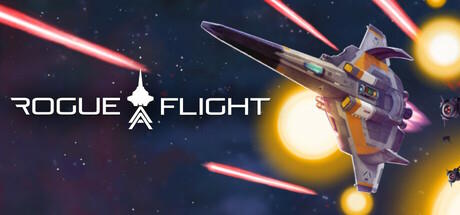Rogue Flight Review
Flying a fighter is cool. They’re fast and maneuverable. They can act with deadly precision. The aesthetics in the fighter plan genre are even cooler. Whether you go for Top Gun, Battlestar Galactica, or Star Fox, you know you are in for some tension between lone wolves with silly codenames. On-rails fighter games used to be a big genre and Rogue Flight is here to blaze a new trail through the sky.
Need For Speed
Rogue Flight evokes the on-rails shooters of old. It plays an awful lot like Star Fox 64, which is probably my most returned-to N64 classic. Your ship flies in more or less a straight line, but you have enough room to maneuver around obstacles. You have a pew-pew laser. There are also bombs to find to refill your finite supply. Levels are more or less the same every time you play but, mastering those similarities is often what gives you access to secret paths or power ups.
There are a few unique spins on the genre, sometimes literally. The jetstream coming out of all the vessels are deadly; it’s dangerous to fly directly behind a big ship. Fortunately, the same goes for your craft. This means your spinning maneuvers (do a barrel roll!) can slice and dice, which calls for some insane high octane flying. Which rules. Nothing captures the sense of speed better than slow-mo slicing apart your enemies like you’re spinning a Lightsaber.
There is little I like more than goofy pilot codenames and Rogue Flight starts you with a pretty good one. But the word ‘rogue’ is in the title, and it refers to more than the legal status of your mission (though it does refer to that too). There are little Roguelite mechanics in Rogue Flight, which is immediately and obviously a fantastic idea. Since the game is about learning through repetition, unlocks keep the game fresh. Some of these, like the aforementioned call signs, a purely cosmetic. But there is some nifty tech to uncover too, things that might change your approach to the levels.
Outer Space Battleship
Beyond calling back to an old game genre, Rogue Flight also wants you to think about 90s cartoons. The style is largely anime, but that’s just skimming the stylistic surface. I loved all the screen artifacts that made me feel like I was plugging the game into my old wooden analogue TV. The character designs made me think first of Neon Genesis Evangelion. Also Gundam Wing. But the story and characters feel more like American an American sci-fi dystopia. (Not that there is a shortage of those in Japanese media).
Attention must be given to the music in Rogue Flight, which rules. There is one instrument more than any other that evokes that kind of flying: electric guitars. And Rogue Flight has them by the busload. Those anime always had rocking soundtracks. Top Gun couldn’t exist without Highway to the Danger Zone. So Rogue Flight isn’t just using any electric guitars- these are the meedly-meedly kind, with practiced, calloused fingers hammering on the highest strings, way down on the guitar’s neck. The Gundam influence is obvious, but the music also evokes cartoons like SWAT Kats. Have I mentioned that it rules?
Elite Squadron
Rail Shooters aren’t exactly a popular genre so Rogue Flight was always going to catch my attention. There were times I was left wanting more. The levels can feel sparse compared to the best of Star Fox and Rogue Squadron. I didn’t spend nearly enough time flying in trenches or shooting steel doors to make a passage. The story, though well presented, never feels personal for anyone beyond the protagonist. That’s the kind of shortcoming felt in a fundamentally successful game- you want to play more of it.
Every inch of Rogue Flight gleams with style. An obvious passion project like this is filled with delightful little details. Playing Rogue Flight is a joy. I’m an easy mark, the second I see something with wings loaded into a tube, I’m already in. And the sky isn’t crowded with a lot of options. Rogue Flight zooms past expectations into a cool, scrappy game.
***PC code provided by the publisher for review***
The Good
- A crazy-fast on-rails shooter
- Retro art and music
- Modern unlock system
The Bad
- Over too soon
- Levels feel a bit empty

